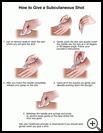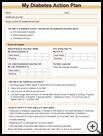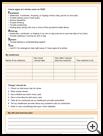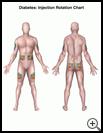
Diabetes: Type 1
________________________________________________________________________
KEY POINTS
- Having diabetes means that there is too much sugar (glucose) in your blood. Type 1 diabetes happens when your body stops making insulin. When your body does not have enough insulin, sugar cannot get into your cells and builds up in your blood.
- The goal of treatment is to control the level of sugar in your blood and keep it in a normal range. You will need to take insulin for the rest of your life (unless you have a pancreas islet cell transplant). You will learn about diabetes, how to test your blood sugar, and how to treat high and low blood sugar. Other important parts of diabetes treatment are diet and exercise.
________________________________________________________________________
What is diabetes?
Having diabetes means that there is too much sugar (glucose) in your blood. Your body breaks down some of the foods you eat into sugar. Your blood carries the sugar to the cells of your body. You need some sugar in your cells for energy, but too much sugar in the blood is not good for your health.
Type 1 diabetes is a lifelong disorder that usually starts in childhood or early adulthood. It’s also called juvenile diabetes. Type 1 diabetes cannot be prevented. There is no screening test for type 1 diabetes in people who have no symptoms.
What is the cause?
Type 1 diabetes happens when your body stops making insulin. Insulin is a hormone made by the pancreas, which is an organ in your upper belly. Your body uses insulin to help move sugar from the blood into the cells. When your body does not have enough insulin, sugar cannot get into your cells and builds up in your blood. Diabetes can damage small blood vessels and nerves, causing problems in the eyes, heart, brain, kidneys, skin, and feet.
The pancreas stops making insulin when cells in the pancreas have been injured or destroyed. What causes this to happen is not always known. It may happen after a viral infection or an injury to the pancreas. It may be caused by a problem with your immune system. The immune system is your body’s defense against infection. Your body's defenses against infection may attack your body's own tissue. When you have type 1 diabetes, the attack is mostly against the pancreas.
What are the symptoms?
Symptoms may start suddenly or they may develop over days to weeks. Not everyone has the same symptoms. Symptoms may include:
- Increased thirst
- Urinating a lot
- Blurry vision
- Feeling tired and weak
- Increased hunger
- Irritability and other mood changes
- Unexpected weight loss
- Fruity smelling breath
If diabetes is not diagnosed and treated, your blood sugar could get so high that you go into a coma and die.
How is it diagnosed?
Your healthcare provider will ask about your symptoms and medical history and examine you. Tests may include:
- Blood or urine tests
- Fasting blood sugar test (FBS). For this test, your blood sugar is tested in the morning after not eating any food or drinking anything except water for at least 8 hours.
- Hemoglobin A1C. The A1C is a blood test that can be used to check your average blood sugar over the past 3 months.
- Glucose tolerance test (GTT). For this test, a sample of your blood is taken when you have not eaten anything since the night before. Then you drink a special sugar drink and your blood is tested again 1 to 2 hours later. Your blood sugar may be tested several more times after the first test, every 30 to 60 minutes.
- Random blood sugar test (RBS) at a time when you have been eating normally.
You may have other blood tests to see what type of diabetes you have.
How is it treated?
The goal of treatment is to control the level of sugar in your blood and keep it in a normal range. Controlling your blood sugar can prevent or delay serious problems caused by diabetes.
When you have type 1 diabetes, you will need to take insulin for the rest of your life (unless you have a pancreas islet cell transplant). You will learn about diabetes, how to test your blood sugar, and how to treat high and low blood sugar. Other important parts of diabetes treatment are diet and exercise.
- Insulin
Different types of insulin may be used to treat diabetes. They differ by how quickly they act to lower your blood sugar level and how long their effects last. You and your healthcare provider will work together to find the types and doses of insulin that will keep your sugar levels in the recommended range. You will need to check your blood sugars, often 4 or more times a day to start. Based on when your sugar is high or low, your daily activities (including meals), and your work or school schedule, you will probably take a combination of insulins, usually a short acting insulin and a longer acting insulin, to give you better control of your blood sugar. Your dosage of insulin may change based on the food you eat and the level of sugar in your blood. If you get too much insulin, your blood sugar could get too low. Low blood sugar can make you feel shaky, faint, have a seizure, or go into a coma.
Shots of insulin may be given under the skin of the thigh or belly one or more times a day. You will learn how to measure your insulin dose, clean your skin, and give yourself shots.
You may be able to use an insulin pump or used inhaled insulin.
Your healthcare provider may prescribe other medicines to help control your blood sugar.
Healthcare providers are working to find new and more effective ways to treat diabetes. For example, surgical transplants of the whole pancreas or just a few cells from the pancreas are becoming more frequent. The transplanted tissue may make enough insulin every day so you can stop taking insulin.
- Blood sugar tests
You will learn how to check your blood sugar with a small machine called a blood glucose meter. Your provider will tell you when and how often you need to check your blood sugar.
You will need to keep a record of your blood sugar measurements. Your provider will check the record at your appointments to see if any changes need to be made to your medicine.
You will have an A1C test every 3 to 6 months to check your overall control of your blood sugar. The A1C test is a way of measuring your average blood sugar over a 3-month period. It’s a good way to see if your diabetes is under control. However, it does not replace daily blood sugar measurements. Daily checks of your blood sugar show whether your treatment is working throughout the day.
- Diet
Your healthcare provider will give you guidelines about which foods you should eat and how many calories to eat each day. Your prescribed diet will include a lot of lean protein, complex carbohydrates (such as whole grain pastas breads, and cereals), fresh fruits and vegetables, and foods with high fiber. You may be able to have an occasional snack with sugar, but your regular diet should not include sugary food such as soft drinks, candy, and desserts. You will also learn how to space your meals so you don’t go too long without food.
Your provider may refer you to a dietitian or diabetes educator for help with meal planning.
- Exercise
Exercise is very important. Exercise improves blood flow, helps your body use insulin better, and uses up more of the sugar in your blood. A good activity plan can help control your blood sugar level. It also helps keep you healthy and avoid some of the problems caused by diabetes. Talk to your healthcare provider about the right activity plan for you.
- Education
When you are diagnosed with diabetes, there is a lot to learn about the disease. This education may be done at your healthcare provider's office, a learning center, or for 2 or 3 days at a diabetes clinic. This education is very important. Ask your healthcare provider about your choices.
Healthcare providers will teach you what diabetes is, and how to give shots of the right amounts of insulin. You will learn how to test for sugar in the blood and for ketones in the blood or urine. You will learn how to treat high and low blood sugar and other ways to stay healthy.
How can I take care of myself?
You can learn to take good care of yourself in a few weeks and you can keep doing almost all of your favorite activities. You need to work with your healthcare provider, change your eating habits, add or continue physical activities, and check your blood sugar on the schedule your provider recommends. Carefully controlling your blood sugar and taking care of any other health problems you have may prevent or delay serious health problems. Follow the full course of treatment prescribed by your healthcare provider. In addition:
- Try to always have your meals, snacks, and exercise at the same times each day. Carry a protein snack, such as cheese and crackers or peanuts, to make sure you eat as often as you should.
- Follow your healthcare provider's instructions for testing your blood and adjusting your insulin dosage according to the results of your blood tests.
- Get your eyes checked as often as your provider recommends.
- Exercise regularly according to your healthcare provider's advice. Wear well-fitting, supportive, and well-cushioned shoes when you exercise.
- Learn how to care for your feet every day.
- Don’t smoke. Smoking speeds up damage to the heart and blood vessels.
- Get other medical problems treated, especially high blood pressure and high cholesterol.
- Carry a medical ID (such as a card or bracelet) that says you have diabetes.
- Learn about diabetes and its complications so you can make the correct decisions to control your blood sugar levels. There is a lot to learn. It's good for your family to also learn about diabetes.
- Following all of the steps to manage your diabetes may feel overwhelming. If you feel stressed or depressed, talk with a counselor.
Ask your provider:
- How and when you will get your test results
- If there are activities you should avoid and when you can return to your normal activities
- How to take care of yourself at home
- What symptoms or problems you should watch for and what to do if you have them
Make sure you know when you should come back for a checkup. Keep all appointments for provider visits or tests. Be sure to take your sugar logs or your glucose meter to all appointments.
You can get more information from:
- The American Diabetes Association
800-342-2383
http://www.diabetes.org




